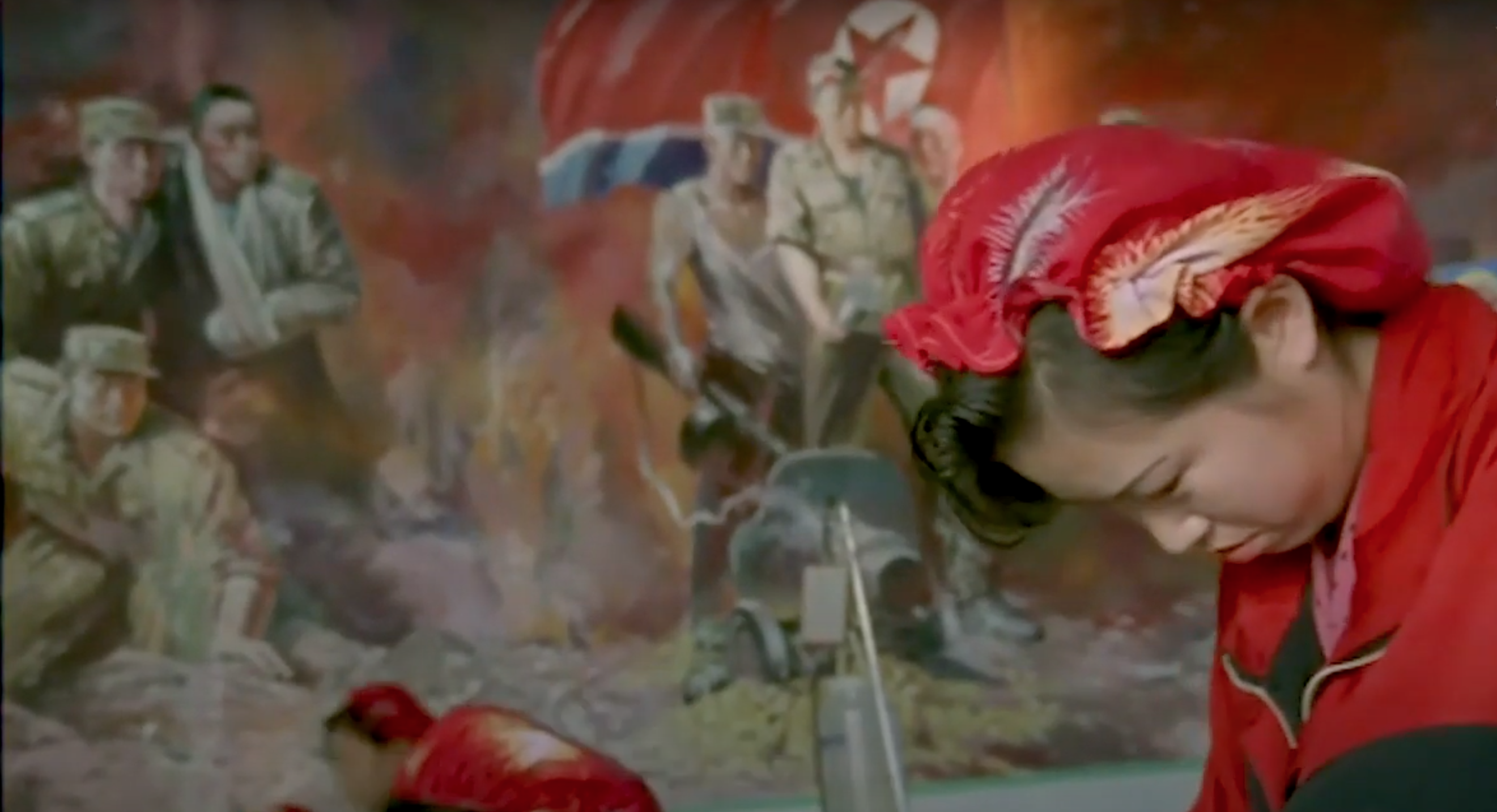
Source: All images in this article are screen captures from North Korea: A Day in the Life.
DIRECTED BY PIETER FLEURY
SEVENTH ART RELEASING, 2004
48 MINUTES, DVD, COLOR
ALSO AVAILABLE ON AMAZON PRIME OR KANOPY
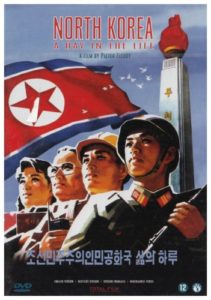
There are many films on North Korea; some are quite good. But Pieter Fleury’s North Korea: A Day in the Life is in a category by itself. In 2004, the Dutch independent filmmaker was granted rare permission to film everyday life in the closed, secretive country. No foreigners are allowed to wander at will in North Korea; all are carefully shepherded and watched, allowed to visit and film only what their hosts decide. These tend to be the same places: a visit to a model kindergarten, to the great statue of Kim Il Sung on Kim Il Sung Square, perhaps a visit to the International Friendship Hall at Mount Myohyang, perhaps to the DMZ. If their timing is right, they can see and film the Mass Games Performances at May Day Stadium. As a result, there is something repetitive about most documentaries made by outsiders, because they contain mostly different versions of the same scenes.
A Day has some of these obligatory scenes; however, its main focus is an ordinary North Korean family: Mrs. Hong Sun Hui, her husband, and her daughter. We watch each of them as they go through one ordinary day of their lives. Of course, Fleury was only able to film what the authorities permitted. It was all clearly staged by North Korean officials, who intended this film to be propaganda boasting of the socialist state they have constructed. We are looking at an officially selected ideal “ordinary” working-class family happily living their life in North Korea’s socialist society. It is, nonetheless, an extraordinarily revealing film both humanizing the North Koreans and at the same time capturing the nature of their isolated, totalitarian society. While it was filmed some time ago, the society it depicts has not fundamentally changed.
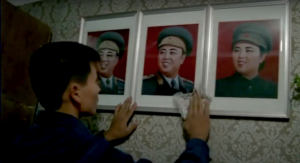
In the beginning, we see the family in their Pyongyang apartment having breakfast and getting ready for work and school. The scene of a busy happy family seems normal enough, except for the father’s careful dusting of the portraits of the ruling Kim family. The apartment itself is modern if basic; the building is drab yet not unlike what is seen in almost any Asian city. The film then cuts back and forth between scenes of the three family members, plus a grandfather. We see Mrs. Hong walking her daughter to kindergarten. The child starts singing a song and her mother joins her. It is a cute scene until the meaning of the song becomes apparent: it is a children’s song about the power of the army and its defeat of the American enemy.
An extraordinarily revealing film both humanizing the North Koreans and at the same time capturing the nature of their isolated, totalitarian society.
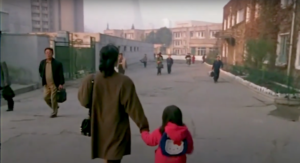
This prepares us for the political indoctrination and militarization that pervade the daughter’s schooling. She enters the school and bows before a portrait of the leader and his family. The teacher then tells the class of cute and often-eager kids the “Story of the Returned Boots.” It’s about the present dictator’s father, Kim Jong Il, who as a young child in the wintry mountain base camp at Paektu Mountain returned the new boots given to him when he saw the other kids did not have any boots. The teacher explains to the children that this shows “why he is the most praiseworthy man on earth.” Before she begins the story, the teacher asks the children if they have ever played in the snow; one mentions that he had made “snow grenades.” We see the portrait of the adult Kim Jong Il on the classroom wall.
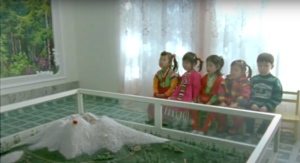
The place the story is set in is not mentioned, but there is a model of the area in the classroom. First, we see Paektu Mountain, a snow-covered peak with a lake-filled crater at the top. This is Korea’s sacred mountain, Tan’gun, the birthplace of the mythical founder of the Korean race, and supposedly of Kim Jong Il. It was from here, North Koreans are told, that Kim Il Sung directed the anti-Japanese resistance. We see a wood cabin where the young Kim Jong Il lived. None of this has any basis in fact; the base camp never existed. Kim Jong Il was born and spent his early childhood in Khabarovsk, Siberia, while his father, after fleeing Manchuria, served in the Soviet Union’s 25th Red Army. Even if one does not know how purely fabricated this all is, the turning of every kindergarten activity into political indoctrination is disturbing. We learn just how important these stories are when we cut to a teachers’ meeting in which a supervisor instructs the teachers on how to present the lesson. On the walls of a school hallway, we see a poster of child soldiers assaulting a hook-nosed foreigner, probably an American imperialist. The children at recess play on a rotating ride sitting in carts designed to look like military vehicles.
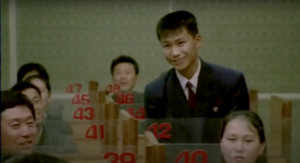
Meanwhile, the father is in an English class. This is the most ordinary part of anyone’s day in the film since the lesson is mostly devoid of propaganda. The only odd note is when one of the students mentions her sister is married to a man with no arms—they were blown off in a military exercise—and how such a marriage is one that brings pride to the family. It seems to suggest that the family may have won advantageous official approval with such a marriage. We don’t see much else of the father’s day except that he sweeps the sidewalk in front of a statute of Kim Il Sung on his way home, ending the day in the same dutiful way he started it when dusting off the portraits.
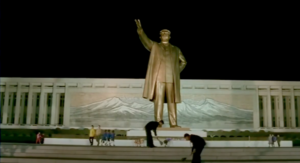
The mother’s day is more revealing. We see her take the subway to work. North Koreans are proud of their subway, whose deep underground stations also serve as bomb shelters. But it looks sterile, devoid of any color except the portraits of Kim Jong Il and Kim Il Sung in the subway car Mrs. Hong is riding. She enters the textile factory, where she wears a standardized work uniform. Instructions are given to the employees about their daily tasks; they are told to work harder, make fewer mistakes, and increase production. The textile workers are all women; only some of the supervisors are men. All are busy sewing jackets while patriotic music about love of country plays on loudspeakers. Mrs. Hong works beneath a large mural of heroic-looking soldiers in combat with a North Korean flag flying in the background. The music and the work come to a sudden stop when an electrical outage occurs. This is blamed on the American imperialists. One of the interesting objects Fleury’s camera focuses on is a chart on the wall with moveable arrows tracking the output of each worker. A similar chart appears on the daughter’s kindergarten class wall.
There is a break in which all the textile workers line up outside and do calisthenics. They are mostly smiling and seemingly enjoying themselves as they move with impressive precision. Yet the image of uniformed workers, exercising in uniformity, reinforces the regimentation of life in the Democratic People’s Republic of Korea. In another scene, we see a plant managers’ meeting, which is more of a self-criticism session. Unit heads admit failure for not anticipating power outages and hold themselves responsible in other ways for the factory’s failure to meet its quotas. In the past, there would have been workers’ self-criticism sessions, but these had become less common when the film was made in 2004. The ordinary workers themselves are subject to constant, sometimes-harsh criticism. When the power comes back on, the workers are told to work harder to make up for lost time. As they resume work, they are continually monitored by women supervisors who are busy jotting down something in notebooks. We see an argument between a textile supervisor and one of the workers over whether she sewed a jacket correctly. While not a heated altercation, it is the only sign of internal conflict we see in the film, and it is effective in making the factory look natural and ordinary.
At times, the camera cuts to quiet scenes of Pyongyang, which with its many high-rises at first glance looks like an ordinary city, if not the most prosperous one. Then we see the monuments to the regime and its heroes. In what is otherwise a rather-gray urban landscape, we see brightly colored posters in the background, untranslated, praising Juche thought, self-reliance, the strength of the armed forces and their inevitable victory over the imperialists. One shows civilians and soldiers appearing to be charging into battle; another one depicts foreigners (presumably Americans) being impaled on a bayonet. In a nice touch, the director’s camera briefly focuses on an older man carrying what might be a door on a bicycle. In several scenes, we see in the background the unmistakable tall, elongated pyramid of the Ryugyong Hotel, a 105-story skyscraper that was intended to be the world’s tallest hotel but was never completed due to structural flaws. Started in the late 1980s, it was designed to accommodate and impress tourists, although the country has few visitors. The useless hulk is an embarrassment to the regime, and it is sometimes airbrushed out of pictures. In another brief scene, we see the Tower of Juche, built in 1982 to commemorate the seventieth birthday of Kim Il Sung, North Korea’s first dictator, father of Kim Jong Il and grandfather of current leader Kim Jong-un. The tower was constructed with 25,000 granite blocks—one for each day of his life—and is the second-tallest monumental tower in the world. We see the huge electric flame at the top lighted, which is done every night. There is a scene of people visiting the International Friendship Hall, although this is not identified in the film. This is a huge museum north of Pyongyang that displays gifts from world leaders to Kim Il Sung and Kim Jong Il.
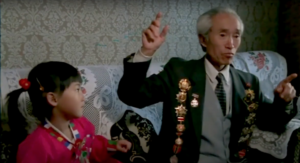
We also see the grandpa visit a memorial to the victims of the Korean War. Later, we see the grandpa at home, wearing his medals, watching television, and proud of the fact that he taught his daughter to say “kill the American dogs.” Speaking to the camera, he explains how his family members were killed by American bombs. We do not know why this particular family was chosen, since it would be the authorities who chose whom to film. The many medals the grandfather wears hints at an answer: this might be the home of a family with a high songbun (loyalty ranking).
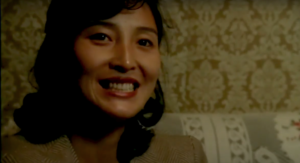
At several points, we hear a radio broadcast in the background. A delegation from China is in the capital and is filled with praise for North Korea’s socialist system. The radio announces that North Korea may return to the Six-Party Talks. These took place between 2003 and 2009 and were made up of North and South Korea, the US, China, Russia, and Japan. Meant to deal with North Korea’s nuclear program, they accomplished little. The news is filled with praises of the great leader Kim Jong Il. This radio broadcast, the propaganda posters, the ubiquitous portraits of the leader, and the patriotic songs heard in the film contrast with people going about the normal routines of their lives to create a sense of oppression.
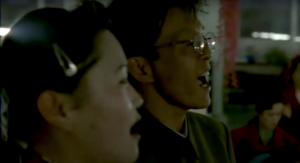
Toward the end of the film, we see Mrs. Hong finish her day at her textile plant. The managers announce the two workers who performed the best that day; she is one of them. Her arrow is moved higher up the chart. Before going home, the workers are led in song. Accompanied by a guitar, they sing how they wish to follow the great leader for eternity: “that is our great joy.” The style of singing might seem familiar to anyone who has visited Korean churches, but in this case, it is a depressing if not chilling reminder of the intense indoctrination woven into almost every aspect of North Korean life.
The regimented, loyal citizens have no doubt been carefully selected, and the scenes are far from candid. Therefore, it may not be a truly representative sample of life in North Korea, but it is probably as close as we can get. And the film does reflect life in North Korea; that is why it is so effective. Everyone is living a sort of normal life, or as best as one can get to normal in this strange, closed, repressive society. We have entered a country where all are watched, where there is no room for spontaneity, individuality, or independent self-expression. People in the film are often smiling and appear happy, but the film left this reviewer with a feeling of sadness that twenty-five million Koreans are trapped in a society like this, while just across the DMZ their fellow Koreans live in a far more prosperous and free nation.

